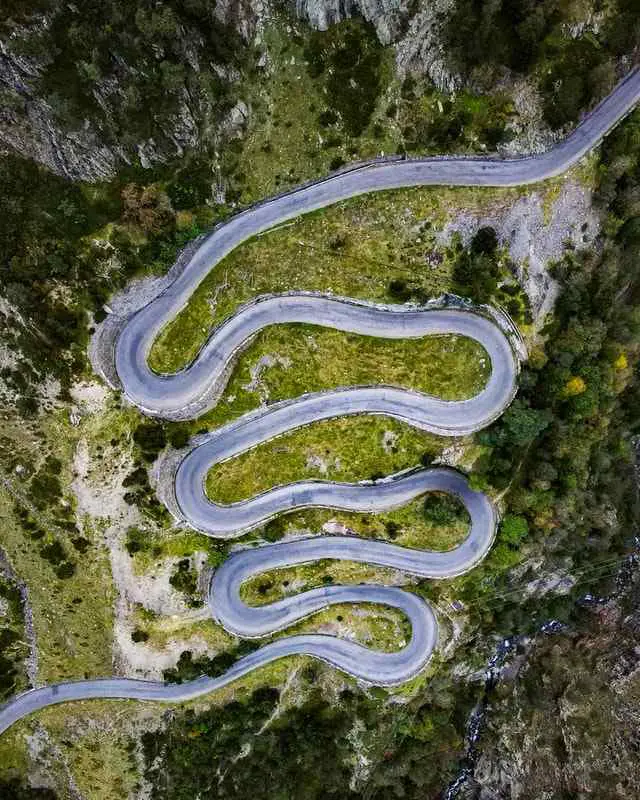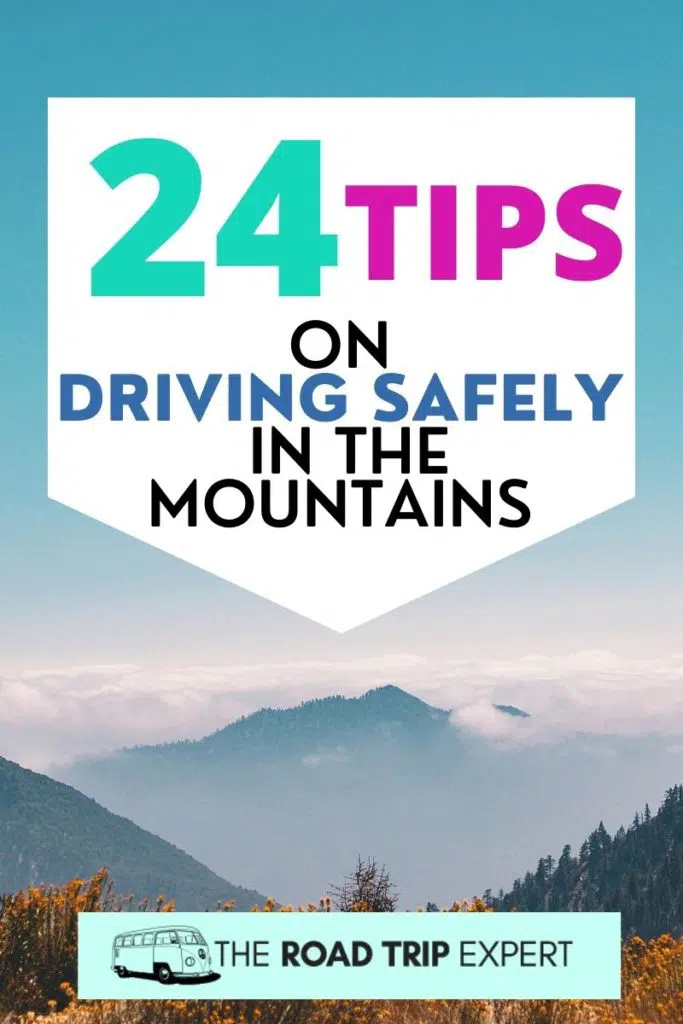Driving on mountain roads can be hard due to the risk of unexpected hazards and variable weather conditions. The frequent tight turns, reduced lighting, and lack of barriers also make mountain driving more dangerous. Checking your vehicle, reducing your speed, and maintaining distance from other cars are easy ways to stay safe on your journey. Prepare for sharp turns and watch out for uneven road surfaces.
This guide will explain how to drive in the mountains safely. We will cover all of the things you need to consider before driving through the mountains on your next road trip.
With these simple tips, you can prepare correctly for a safe and comfortable journey.
Affiliate Disclosure: Thank you for supporting The Road Trip Expert. When you purchase through links on this site, we may earn an affiliate commission. Please see our advertising disclosure for more details.
Check your vehicle lights are functioning
Good visibility while driving is crucial, but being visible to other road users is just as important. Make sure your fog lights are functioning as well as the main beam headlights. Reduced road lighting may require you to rely on your car’s lights to see clearly. Hazard lights are also important.
Inspect your vehicle
All aspects of your vehicle should be inspected before driving in the mountains. This includes essential fluids such as engine oil, water, and coolant. Check your tire pressure and condition are satisfactory and don’t forget to test all the lights. Windscreen wipers are essential as are your hazard lights in case of a breakdown.
Be ready for vehicle breakdowns
The mountains will often have long distances between rest stops and so breaking down can result in serious inconvenience. In addition, there often aren’t great places to pull over and attend to a problem. A good Roadside Emergency Kit will at least give you the items needed to make yourself clearly visible to other road users.
- Quality Materials: Our Car Emergency Kit is packed…
- 90-Piece Premium Roadside Assistance Set: Our kit…
- Additional Kit: We’ve included only the best tools…
Fill up your tank
As previously stated, rest stops can be few and far between while driving through the mountains. Not only this but gas can be more expensive. For a stress-free trip fill up your tank beforehand to reduce the risk of any gas-related worries.
Plan your route carefully
Cellphone reception can be intermittent in the mountains. Download your route as an offline map on Google Maps or alternatively use a paper map. Make sure you are aware of the distance between rest stops and plan accordingly. It’s a good idea to use the bathroom prior to entering the mountains as service areas are infrequent.
Download some awesome playlists
Another downside of reduced reception is that you are unable to access your favorite streaming services. Download one of our awesome Road Trip Playlists before departure and have a sing-along!
Check the weather before departure
The weather can change quickly during mountain driving so it’s important to be aware of the forecast in advance of departure. If there is likely to be heavy rain make sure your windscreen wipers are working correctly.
Maintain distance from other cars
You should maintain more distance than usual when driving on mountain roads due to unexpected braking that may occur due to an obstacle or hazard. Give yourself plenty of time to react by keeping back from other vehicles.
Watch out for uneven road surfaces
It’s common to have potholes or damaged road surfaces in the mountains. They tend to be exposed to poor weather and are less accessible to maintenance teams. Keep your eyes on the road to avoid unwanted damage to your vehicle by driving over a pothole.
Use lower gears when driving downhill
When driving down a mountain you should use lower gears in order to provide additional engine braking in the event that you need to slow down quickly. If you encounter a hazard or an uneven road surface you can stop more effectively which results in a safer trip.
Pay attention to the signage
Signage is key to understanding hazards that lie ahead. This may be changing in the incline of the road, animals, or even potential rockfall. Take your time while navigating your route and adjust your driving accordingly upon seeing a sign.
Manage your speed when entering turns

When you are driving in the mountains you may find that there is quite a high-speed limit due to the remoteness of the location. Accidents are frequently caused by entering bends at excessive speed. Make sure you are entering turns at an appropriate speed given the risk of a tightening of the bend or an unexpected hazard.
Be prepared for road hazards
When you are driving through the mountains you may encounter hazards such as animals, debris, rockfall, or uneven road surfaces. Be aware of this and adjust your speed accordingly.
Use main beam headlamps at night
Mountain roads often have reduced or no lighting. Provided you are not using them when there is oncoming traffic or a vehicle in front of you, the main beam will provide increased visibility. Visibility is key in order to react to unforeseen obstacles or sharp turns.
Downshift during steep incline routes
In order to protect your engine, you should be prepared to use the full range of gears on your vehicle. When you are driving on an incline you should use lower gears.
Be prepared for unexpected tight turns
When you are driving in the mountains the road design will of course be governed by the terrain. This can result in frequent and unexpected tight turns. It is not always the case that clear signage will warn you of this so you should prepare for the unexpected.
Use caution when there are no road barriers
On stretches of road with no road barriers, there is an increased risk of severe incidents. This is because drop-offs are common and a vehicle accident could result in considerable injury. You should drive slower than usual and use the center line as a guide for your vehicle positioning.
Never pass other vehicles on blind corners
Overtaking in the mountains should be done with extreme caution. Only do it when you have assessed the situation carefully and have clear visibility of the road ahead. Never overtake on a blind corner and be especially conscious of the lack of crash barriers.
Monitor the temperate gauge of your car
Driving on steep inclines in lower gears can put increased strain on the engine, especially at high altitudes. If the car is struggling make sure you are in a low enough gear and pull over to let the car rest if you see the temperature gauge rising in a concerning way.
Turning off the AC can reduce strain on the engine and of course, pulling over is an option too.
Use the parking brake if you pull over
Some of the most amazing scenic drives are in the mountains. If you pull over to take a break or take in the view, always remember to use the parking brake to prevent your vehicle from rolling away. Inclines can lead to accidents if you forget to do this.
Do not cross onto the other side of the road
It can be tempting to use the whole road when in the mountains as there are often no other road users. The problem with this is that visibility around corners is often limited so you might suddenly encounter someone else coming in the opposite direction and cause an accident. Stay on the correct side of the road and drive appropriately for road conditions.
Allow impatient road users to pass
Do not feel pressured to drive any faster than feels safe. If you find another car is tailgating and wishes to pass, allow them to do so. Either pull over or find an appropriate road to slow down on and allow them to overtake easily.
This is something we have talked about before in our article outlining the best Road Safety Tips
Be observant of any animals
Sometimes you may encounter wildlife on your journey. They are not aware of the risks of the road so it is up to you to drive slow enough to react if there is an animal on the road. Animals may freeze in the headlights.
Enjoy the view
Some of the most scenic drives are in the mountains. Take some photos to capture the moment as you navigate the windy roads. Perhaps stop at a rest area for a picnic and enjoy the fresh air of the countryside.
We hope you have found this guide useful. Please let us know in the comments if you have any other mountain driving tips we should add to this list!
Disclosure: Some of the links in this article may be affiliate links. This means I earn a commission if you make a qualifying purchase, but this is at no additional cost to you. Thank you for supporting The Road Trip Expert.


